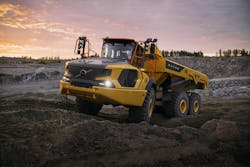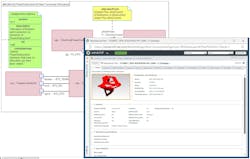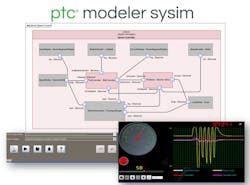MBSE Roadmap for Design Engineers
Key Highlights:
- MBSE creates a comprehensive, digital "single source of truth" for complex machinery systems, enhancing collaboration across engineering teams.
- The methodology shifts focus from detailed CAD modeling to abstract, visual system models early in the design process, reducing errors and rework.
- While initial costs are high, MBSE offers significant long-term savings by minimizing mistakes, improving compliance, and accelerating time-to-market.
Enjoying Machine Design’s Industrial Equipment & Heavy Machinery content? Be sure to check out the rest of our Takeover Week coverage here.
If you’ve been tasked with finding a technical solution for a heavy machinery component, you’d likely leaf through pages of requirements, establish constraints and targets, collect insight from other engineering teams, develop concepts and enter the specs for your chosen solution into a CAD model.
By the time you’re at the CAD stage, you’re digging into component-level details such as specific dimensions, tolerances and materials.
But what if, after spending considerable time fine-tuning your model, you attempt to integrate or test other parts only to find a system data connection is physically incompatible? Or another engineering team dumps your model into their own modelling, and specifications get lost in translation? Or a requirement changes and you don’t have visibility on how parts of the mechanical design might be affected? Or you’ve already built a prototype or even the hardware, and then need to make an adjustment based on updated safety regulations?
“It costs money.”
That’s how Harlen Dean, ALM solutions consultant and MBSE worldwide technical lead at software provider PTC, summarizes the effect using traditional design engineering methods can have on complex, safety-critical applications.
READ MORE: The Digital Evolution of Heavy Machinery—Understanding Model-Based Systems Engineering
PTC’s client, Volvo Construction Equipment (Volvo CE), wrestled with this cost equation for its Hauler line of business four years ago as the addition of smart software made the system architecture more complex and required frequent changes. Engineers were spending hundreds of hours combing through paper-based and digitized specifications from various engineering teams, customers and regulatory bodies to research dependencies every time they had to update a part.
In order to maintain and ultimately grow their market share in the core earthmoving vertical, Volvo CE needed to reduce time to market and protect their intellectual property while satisfying regulatory, quality, safety and product complexity requirements.
They turned to model-based systems engineering (MBSE), which has been billed by software companies as a solution to save money and time, and to improve efficiencies through comprehensive, traceable documentation and models. MBSE, long used in the aerospace and defence industries, is increasingly being deployed in the heavy machinery and automotive sectors.
Because it’s a methodology that demands a complete, years-long overhaul of existing workflows, MBSE is sometimes met with reticence by engineers comfortable with tried-and-true processes and by C-suite executives uncomfortable with waiting for a return on investment.
Project budget is important to design engineers, but they’re not always laser-focused on costs—they’re after the best technical solution, after all. MBSE challenges mechanical, software, hardware, electrical and hydraulics engineers to think more like systems engineers and zoom out to make decisions that consider the whole.
That’s the point, says Dean. “Get it right early on before you build, because then you have less problems.”
How MBSE Works
MBSE is a “system of systems” that carries a product through from conception to manufacture. It pulls in requirements tools such as application lifecycle management (ALM) software to determine rules and desired behaviors for architecture, the mechanical, software, electrical and hydraulic systems and components, then pairs them with abstract visual models using a common language (e.g., Systems Modeling Language, or SysML) to establish a single, consistent framework, before physical parts or software code are built.
Traditional requirements documents can lead to ambiguity or misinterpretation by an engineer. Volvo CE now uses PTC’s Codebeamer ALM software and SysML’s structured syntax to enforce precise semantics that turn text-based statements into machine-readable constraints. This allows for automated testing and traceability on its haulers from the start.
Using PTC Modeler, Volvo CE’s engineers describe the behavior of the hauler’s system through use cases and activities, along with sequence and state machine diagrams that outline how the machine is going to work. All teams can concurrently design, test and analyze a living digital representation of each of the system’s conceptual parts.
Each component is linked back to its original requirement so that when there is a design issue or error, it can be fixed according to the correct documentation. MBSE connects the architecture to the behavior and final code, which makes it easier to perform safety-critical analysis. This continuous, bidirectional flow of information is a digital thread.
READ MORE: Physical AI in Motion—How Machine Learning Drives Next-Gen Industrial Automation
Once Volvo CE’s teams have evaluated the models for defects and analyzed functionality, the models can be further refined into detailed designs of working systems. From there, MBSE connects to PTC’s Windchill product lifecycle management (PLM) tool to manage all the usual physical product data from bill of materials and CAD files to manufacturing instructions and engineering changes.
All documentation in the MBSE process travels together digitally until it reaches the manufacturer. When it’s time to submit physical copies to the certification authority, the necessary information is already gathered in one place to expedite output. MBSE can handle configuration management so that updates reflect across the documentation, architecture, code and variants for all models and components.
As field data on working machines is collected, it can be added into the model. Volvo CE is working to incorporate its 100,000 IoT devices into its model to create a continuous digital feedback loop. Sensors supply live data so engineers can verify the effectiveness of their design decisions and further refine the system for future updates.
Using all these tools, MBSE creates a single source of truth that anyone can refer back to, making it well suited for complex applications like Volvo CE’s haulers that carry risk to human life. MBSE’s traceability and built-in checks ensure the haulers follow strict adherence to ISO 26262, which covers safety of electrical and electronic systems, in the same way that aerospace applications use MBSE to follow DO 178 for safety of airborne software.
Designing in the Abstract
To implement, PTC evaluates the existing systems engineer process, whether it’s something like ISO 15288 or the Object-Oriented Systems Engineering Method (OOSEM), and then points it to an MBSE model.
MBSE requires a fundamental shift in thinking compared to those processes. Design engineers have long relied on CAD models to understand and visualize how components will perform, but MBSE’s main modeling happens well before the CAD stage, using diagrams of abstract shapes—pink boxes, in PTC’s case.
Dean acknowledges MBSE is “quite an out-there concept.”
Design engineers are technical folk, so the idea of forgoing a detailed model in favour of a generic box takes some adjustment. That was the biggest hurdle for Volvo CE’s implementation, says Dean.
“A diagram says a thousand words, just like a picture says a thousand words,” he says. “Everyone understands requirements, but being able to push that into a model-based form? Visualization can be tricky for some people.”
The generic box, known as a block in SysML, represents the “what” (the behaviors and structural composition) without being prematurely constrained by the physical “how” (the specific dimensions, tolerances or materials in CAD). The block is not meant to be a replacement for CAD; the details come later in the process.
To make the mental leap, Dean advises teams to practice with components they already know. PTC used Volvo CE’s latest hauler design for its implementation and brought in a consultant to train the team in the MBSE methodology and process.
Once Volvo CE’s engineers understood SysML and had the chance to see dependencies and solve errors before a single resource was physically created, the value became evident. Using PTC’s Modeler, they saw they could do things like reuse the main model to change dimensions instantly, or swap out multiple versions of a part’s component to correspond to the size of the hauler, all with the click of a button.
Making MBSE Make Sense
Hesitancy about MBSE is common among design engineers who view increasing digitalization as a threat to job security.
Like with all things digitalization, MBSE refocuses human efforts away from non-value-added tasks, and onto more challenging activities like creating bespoke code and protecting intellectual property.
Because it’s a methodology that starts in the requirements phase rather than the design phase, some engineers view MBSE as a way to spend more time getting lost in metrics and not enough time on design.
It all depends on the application and how it’s integrated. “Sometimes doing MBSE actually makes you less efficient because you’re not designing quickly enough,” Dean says. “You have to look at the systems that really need to be used.”
That’s what MBSE is about: designing with the system instead of designing because of it.
Where some applications fail is in non-complex scenarios, or if the engineering team hasn’t been adequately trained, or if there isn’t a solid systems engineering process already in place to work from. If full-scale MBSE is not the right fit, Dean suggests teams consider at least improving traceability using a requirements management tool instead of relying on Excel.
The Cost/Benefit of MBSE
Integrating MBSE is somewhat of a catch-22—it costs a lot of money for a company to do. But it can cost more if they don’t.
Dean points to an aircraft engine manufacturer client that now completes 80% of its design in MBSE’s requirements and system engineering phases. Eight-five per cent of the code structure for its engines is now automatically generated through PTC’s Modeler, and engineers can concentrate on producing the remaining 15% of detailed, safety-critical coding specific to the company’s intellectual property.
“Did [MBSE] disrupt their process? Yes, it did, because it took two years to really get a good understanding,” Dean says. “When it’s complex systems like engines or haulers or anything with high certification, it takes a good couple of years to really get your process and your methodology.”
READ MORE: Modeling Machine Designs that Seal Deals
Volvo CE is now at full system integration for its haulers and currently captures between 15–20% gains on time efficiency. Dean expects that to increase as the team gets increasingly familiar with their process, which tends to see average improvements of 25–45% depending on product variability.
The transition period requires patience and retraining, but the long-term strategic advantage of MBSE for safety-critical complex applications is clear. “The return on investment seems like there’s nothing to start with, but once you get to that point, then the return on investment exponentially goes up quite quickly,” says Dean.
The question for companies such as Volvo CE is slowly shifting from the cost of implementation to the cost of staying stagnant.
However, MBSE isn’t a silver bullet. All teams must be properly trained on SysML so they speak the same language and understand how to read the models. “Reaching the point [where MBSE is at peak efficiency] is very difficult,” says Dean—but it’s possible with the right methodology.
“Follow a good process. If you don’t, it’s going to be all over the place,” he advises. “It takes time to adjust to the new process, but in the long run, it makes you so much more efficient because you make fewer mistakes.”
About the Author

Kristina Urquhart
Kristina Urquhart is an award-winning writer and publisher in Toronto, Canada who, since 2007, has covered a variety of industries including manufacturing, technology and business.



